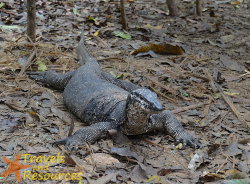 The one thing I was unable to do during my first visit to the Underground River was to look at the Bayawak, or Monitor Lizard.
The one thing I was unable to do during my first visit to the Underground River was to look at the Bayawak, or Monitor Lizard.
The reason for this failure was that I was too busy taking pictures of the Underground River and the monkeys that I ran out of time.
Thinking that I had to walk a long way down to a creek, I opted to skip a quick look when it was time for us to head on home.
Too bad though; had I just followed the sign I would have seen a bunch sunning themselves a few steps away from the main hut.
Table of Contents
Background
The Bayawak, or Marbled Monitor Lizard is a rather large reptile that can grown up to a length of 200 centimeters or 6.5 feet. The ones found in the island of Palawan is said to be an entirely new species of Bayawak.
They are carnivores and count fish, frogs, rodents, birds, crabs, snakes, turtles, and even small crocodiles. It has also been known to also eat eggs, insects, fruits, and the decaying bodies of other wildlife.
Interestingly, these creatures are very helpful in keeping the area clean because hardly anything is wasted.
[Ah, but I haven’t heard of one eating dog poop like my Hermit Crabs.]

Marble Monitor Lizard Sign
They are excellent swimmers, sometimes being seen swimming from one island to another. They are also able to climb trees with their long claws helping them grip tree bark.
They have no venom glands, but their saliva is poisonous as it carries a cocktail enough to give its prey blood poisoning. After biting animals, they just wait until their prey literally drops dead before eating it.
Some studies indicate that these lizards as very intelligent, with some species being able to count.
Being a reptile, is a cold-blooded creature that needs the sun to warm up before it becomes active. Its body is covered in thick scales that act as armor. The Marbled Monitor Lizard of Palawan has a dark brown skin with black stripes and white dots, making it resemble marble rock. The skin is thick enough that puncturing or cutting the skin can be difficult.
It has a long tail that is armored as well. It uses the tail, mostly in self-defense like a whip. Some of the locals say that it is strong enough to knock down a full-grown human.
Many people think that because it has a slow lumbering movement, it can’t catch anything. But some people I have spoken to say that Bayawak on the island can be quick, especially after being sufficiently warmed by the sun. They are so fast, that they are supposed to be able to chase down Wild Boar, Deer, and even a dog under ideal conditions.
Since some prey will be bigger than the Bayawak itself, it rips off bite-sized chunks of the prey it is feeding upon. And when it eats, it does not dine alone. It is usually joined by other Bayawaks in its pack for a feast.
Eating is a messy exercise and can be chaotic as different Bayawaks will vie for a piece, so expect small bits to be flying around when parts are torn. Also, expect a lot of flies to be present.
Location
If you are on the island and facing the structure housing the restrooms, just follow the path going to the right.

Marble Monitor Lizard
You’ll find a pack of them slowly walking around on the clearing to your left, a few steps in to the path.
I was actually surprised as to how close they were to visitors. I was expecting them to be somewhere down a creek or ravine sunning themselves.
[What startled me as I was walking was a dark figure slinking in my peripheral vision.]
Careful
Like I mentioned earlier, these Bayawaks can move really fast. And since their saliva is very poisonous, they will give you blood poisoning if bitten. So, try not to annoy them as you take pictures.

Marble Monitor Lizard
They also use their tails as whips, so make sure to stay a good distance away from their backs.
Under any circumstances, do not try to feed them. When one Bayawak sees food and goes for it, all the others will do the same.
[Feeding frenzy!]
Marbled Monitor Lizard
Even without being able to get up close and personal, I can’t help but see that these are beautiful creatures. The marble color of their skin is amazing.

Marble Monitor Lizard
And just like the Crocodiles in the Crocodile Farm, they are powerful and rather hypnotic to look at. Even the tongue, which they flick out to taste if food is in the air casts a hypnotic spell.
Some conservationists swear that they are great to raise, but the ones in front of me are wild and untamed.
As I was talking pictures, I noticed that one of the Bayawaks had part of its tail cut. A word with one of the locals indicates that it was probably lost in a fight with another Marbled Monitor Lizard.
[Their color makes them favorites.]
Lizard vs. Monkey
So, you wish to learn the superior fighting technique, do you Grasshopper? And by the fates, you wish to choose between the Lizard Tail or the Monkey Hand techniques, do you?

Macaque
Well, while the Bayawak is armored, has a fast whip-like tail, and poisonous saliva, it lacks one thing – it does not fight in packs. It may hunt or feed in packs, but when it fights, it does so alone.
On the other hand, the Macaque tends to do everything in groups, including fighting. And it is this act of cooperation that defeats the Bayawak.
Our guide Dean San Luis was telling us a story of when a pack of Bayawaks and group of Macaque were fighting. The monkeys would pour all their attention to one Bayawak at a time by ganging up on it. One would one would be on its back, and one grab a leg, and one would hold on to the tail.
According to Dean, once the tail is under control, the Bayawak will have difficulty fighting so many monkeys. In the end, if they are all vying for the same meal, the Macaque will end up running away with the food.
Ah, but if the fight was just between one Bayawak and one Macaque in a tight space, I understand that the monkey won’t be walking out alive.
So now you know which technique is better, grasshopper. One on one, the Lizard Tail wins; but when working as a group, the Monkey Hand is superior.
[Use this knowledge wisely grasshopper.]
Final Thoughts
Seeing these amazing creatures is what I was looking forward to on my return to the Underground River.

Marble Monitor Lizard
Seeing them in their natural habitat did not disappoint. They are powerful, hypnotic creatures that are utterly fascinating.
I hope that current conservation efforts continue to keep them safe so others, such as myself, can enjoy seeing them.
Till the next time, keep your camera batteries fully charged and your memory free because you may need them for the next place you visit!
Must Do’s
- Bring a camera with lots of memory and batteries.
- Keep a safe distance between you and the Bayawaks.
- Use a zoom lens so you don’t need to get up close and personal.
- Do not feed the Bayawaks.


Comments are closed